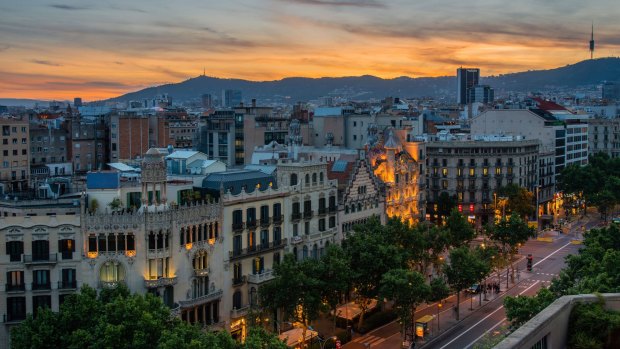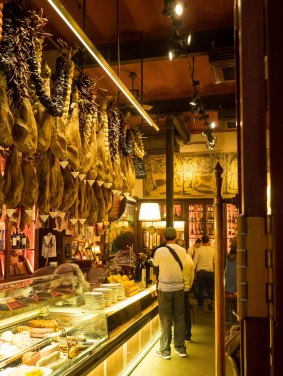This was published 5 years ago
Revisiting Barcelona: Is it a city worth returning to?
By Nina Karnikowski

A sunset view of Barcelona, one of the world's most vibrant and avant-garde cities.Credit: Alamy
The last time I stood here, looking up at Barcelona's famous La Sagrada Familia, it was 2006 and my three girlfriends and I were making a pact: let's never return to this city, as long as we all shall live.
Yet here I am. The shards of a broken promise at my feet, as 12 years peel away to reveal the distressing situations that led to our oath. The make-your-own-sangria-fuelled cooking class. The accidental splitting of our group on Las Ramblas. The swiping of my friend's bag at dinner. My other friend and I hiding from some undesirables in a nightclub bathroom.
That our youthful foolhardiness was as much to blame as the city was a fact that took me more than decade to admit. As author Alain de Botton rightly reflects in his philosophical tome The Art of Travel, "a danger of travel is that we see things at the wrong time, before we have had a chance to build up the necessary receptivity and when new information is therefore useless and fugitive as necklace beads without a connection chain".

A tapas bar with hanging jamon over the counter is part of the city's top drinking and dining scene.Credit: Alamy
Realising that perhaps I wasn't ready for Barcelona back then, I decided it deserved a second chance. This time around, however, I'd do it right, putting myself in the hands of luxury tour experts Abercrombie & Kent, to present Barcelona to me in her most flattering light.
As we enter the neo-classical facade of the El Palace Hotel, and wander through the gilded lobby, I'm visited by the ghost of poor accommodation choices past. Back in 2006, a grande dame hotel with a fancy doorman was something my friends and I could have only dreamt of. In those pre-Airbnb days we'd rented an apartment, sight unseen, off a strange man at the train station. We'd headed to the city's outer limits to find our digs were flea-infested and had cockroaches in the coffee. It hadn't gotten us off to the best start with the Catalonian capital, I realise as I sip tea on the El Palace rooftop pool terrace with 360-degree views over the city.
Soon, my travel compadres and I are wandering old Barcelona's sun-splashed laneways in search of the city's most impressive architecture, something I couldn't have cared less about at 22. Our first stop is the Palau de la Musica Catalana concert hall, one of Barcelona's best examples of Modernista architecture, created by architect Domenech i Montaner in 1908. Studying the stone pillars covered in intricate floral mosaics embellishing the facade, I realise I probably walked right past this extraordinary building 12 years ago. More fool me if I did. Because entering the upstairs auditorium, a kaleidoscope of ceramic roses, chandeliers, sculptures and stained glass, feels like walking inside a life-sized music box. I understand our guide perfectly when she says you can feel that this structure, originally built for the Orfeo Catala musical society, was the love child of people united by music. Some may find the building over the top, but to me it is music in physical form.
As we continue walking, I wonder how I could have once overlooked the psychedelic mosaiced facade of Antoni Gaudi's Casa Batllo as we pass it, and the wave-like stone balconies of La Pedrera. Perhaps I hadn't matured enough to find these buildings worthy of appreciation. Or maybe I was so cranky at the city by that point that I'd simply had my blinkers on.
The real star of Barcelona's architectural show however, Gaudi's Sagrada Familia, I did see 12 years ago – although only for the three minutes it took to snap a selfie in front of it. I knew nothing about Gaudi the man, or the significance of his avant-garde masterpiece, which attracts 3 million tourists annually. Today, happily, we have Abercrombie & Kent's art expert Maria Teresa Farriols accompanying us, a petite, animated, Gaudi-obsessed blonde. "There are three men in my life," she tells us, "Gaudi, Dali, and my son."
Farriols walks us around the exterior of what will eventually be the world's tallest church, when it finally gets completed in 2026. The first stone was laid in 1882, she says, adding that the Catalan architect believed God had all the time in the world so there was no need to rush it to completion. We marvel at the dizzying spires and botanical and religious sculptures covering the exterior, before heading inside. The soaring vaulted ceilings leave us feeling as though we've entered a gigantic stone forest, while the Murano stained glass throws rainbows across the floor. "Gaudi took inspiration from his dreams," Farriols whispers, "he was connected to a higher force." She explains the intricacies of the debate that has raged for more than a century about whether this mind-bending building is genius or folly. No matter which side of the fence you sit on, it's an undeniably brilliant feat of imaginative construction that it's almost impossible not to be moved by.
Later, as I wander the boutique-lined laneways of the medieval Born district, I get to thinking about timing in travel. Maybe, instead of lamenting all I missed during my first Barcelona trip, I can appreciate all I've learnt about travel in the 12 years since.
How to properly research and plan for a trip, yes, but also how to give a destination's history and culture the appreciation it deserves.That includes culinary culture, I realise as our small group sits for supper at a trendy, intimate downtown tapas restaurant named Casa Lolea. In 2006, my friends and I had skipped dinner in favour of taking a cooking class.
Which sounds classy. Until you discover the class was run by a company called Smashed. And that other than learning how to make bastardised sangria, all we really learnt to cook was tomato toast.
Tonight, however, we get a taste of Barcelona's world-class drinking and dining scene. We sip organic sangria and nibble lip-smacking morsels of pickled octopus, tuna ceviche, melt-in-the-mouth jamon and creamy patatas bravas. We toast, we chat, we laugh. It's a near-flawless Catalonian food experience, and the perfect prelude to phase two of our night.
Soon, we're picked up in classic red and bottle-green sidecars and, as the day starts to fade, we whiz through the boulevards of the elegant Eixample district and the Gothic Quarter. No wonder Barcelona so inspired artists like Picasso and Miro, I think as the wind whips my hair and the city lights start twinkling all around us.
Arriving at the Montjuic hilltop, we clamber out of our sidecars for a glass of cava, Spain's moreish sparkling wine. As I sip, I gaze out over the sprawling city. How, I wonder, could I have ever used the word ''hate'' in reference to one of the world's most vibrant and avant-garde cities? I raise my glass: to Barcelona, for finally showing herself to me, to growing up, and to second chances.
TRIP NOTES
MORE
FLY
Cathay Pacific flies from Sydney to Barcelona via Hong Kong.See cathaypacific.com
TOUR
Abercrombie & Kent specialises in private and small group journeys to Spain. An eight-day private journey through the north of Spain, including two nights at Hotel El Palace Barcelona, two nights in San Sebastian, two nights in Bilbao and two nights in Madrid, is from $14,855 per person twin share. See abercrombiekent.com.au
Nina Karnikowski travelled as a guest of Abercrombie & Kent and Cathay Pacific.
Sign up for the Traveller Deals newsletter
Get exclusive travel deals delivered straight to your inbox. Sign up now.